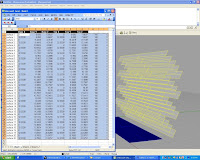Last spring, while attending a semester at the
Ecole Speciale D'Architecture the studio was introduced to rhino scripting techniques at a workshop conducted by
Edmondo Occhipinti. The studio ; Eco-Logical High-rise, focused around the idea of utilizing various computational methods and software for design performance, evaluation, and optimization.
This script was developed in collaboration with Martin. It creates a series of 12 points from equations derived for the construction of a unit circle, implements a directional deviation of either a single or double point, and draws a closed curve through the set of points. The script was used to generate floor plates that respond to prevalent wind direction, either by developing a 'bulge factor' in the direction of the wind or against it. It was imagined that the implementation of this method in the design could be used to have parts of the building that were capturing the wind for energy-generation purposes and others that were repelling the wind for structural reasons.
Voici le script et quelques images:


Option Explicit
'base floor curve from points'
Call DrawCurve
Sub DrawCurve
Dim r
Dim bulgefactor
Dim i
Dim j
Dim arrpt1, arrpt2, arrpt3, arrpt4, arrpt5, arrpt6, arrpt7, arrpt8, arrpt9, arrpt10, arrpt11, arrpt12
Dim arrpts
Dim arrcrvpts
Dim crv1
bulgefactor= Rhino.getreal ("choose bulge ratio")
r= 1.0477787091366303436714165968148*Rhino.getreal ("identify RADIUS", 1,0)
i= ((3/2)*Rhino.getreal ("choose the inflatement ratio for ETE", bulgefactor,-2))/1.0477787091366303436714165968148
j= ((3/2)*Rhino.getreal ("choose the inflatement ratio for HIVER", -bulgefactor,-2))/1.0477787091366303436714165968148
arrpt1= array (0,r)
arrpt2= array ((r+i*r)/2,(r+i*r)*Sqr(3)/2)
arrpt3= array (r*Sqr(3)/2, r/2)
arrpt4= array (r,0)
arrpt5= array (r*Sqr(3)/2, -r/2)
arrpt6= array (r/2, -r*Sqr(3)/2)
arrpt7= array (0,-(r+j*r))
arrpt8= array (-r/2, -r*Sqr(3)/2)
arrpt9= array (-r*Sqr(3)/2, -r/2)
arrpt10= array (-r,0)
arrpt11= array (-r*Sqr(3)/2, r/2)
arrpt12= array (-r/2, r*Sqr(3)/2)
arrpts= array (arrpt11, arrpt12, arrpt1, arrpt2, arrpt3, arrpt4, arrpt5, arrpt6, arrpt7, arrpt8, arrpt9, arrpt10, arrpt11)
'arrcrvpts= Rhino.addpoints (arrpts)
crv1= Rhino.AddCurve (arrpts,3)
End Sub


















